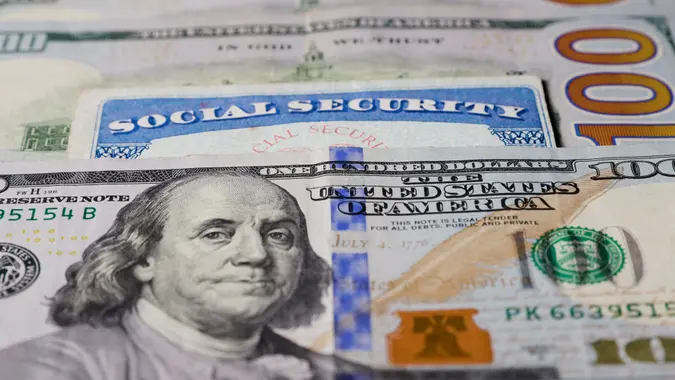How to Retire Early With No Money: 7 Steps to Make It Work

Commitment to Our Readers
GOBankingRates' editorial team is committed to bringing you unbiased reviews and information. We use data-driven methodologies to evaluate financial products and services - our reviews and ratings are not influenced by advertisers. You can read more about our editorial guidelines and our products and services review methodology.

20 Years
Helping You Live Richer

Reviewed
by Experts

Trusted by
Millions of Readers
If you’ve been wondering how to retire early with no money, the truth is that while it’s not easy, it’s still possible with the right strategy. Retiring early without savings requires serious lifestyle changes, creative income sources and full use of government programs. The good news? With planning and flexibility, you can build a modest but fulfilling retirement, even starting from zero.
This guide breaks down seven practical steps to make early retirement possible — from cutting expenses and tapping benefits to exploring part-time work and affordable living options.
1. Assess Your Current Situation
Before making any big decisions, take stock of your financial picture.
- Social Security: Benefits are available as early as 62. The average monthly retirement benefit in 2024 is $1,907, according to the Social Security Administration.
- Assets: This could include home equity, even if you don’t have cash savings.
- Debt: Pay off high-interest debt first. The Federal Reserve reports that the average credit card interest rate is now 22.8%, which can eat away at limited retirement income.
2. Reduce Expenses to the Lowest Possible Level
Extreme frugality becomes a necessity when you’re retiring with no savings.
- Downsize to a smaller home or consider renting a room. Housing makes up about 33% of retiree spending, according to the Bureau of Labor Statistics (BLS).
- Cut out non-essentials like multiple cars, unused subscriptions and dining out.
- Consider shared housing or living with family to cut costs dramatically.
3. Explore Income Options for Early Retirement
Even without a big nest egg, you can still generate income.
- Part-time work: Seasonal jobs, tutoring or consulting in your field.
- Side hustles: Driving for rideshare services, pet sitting or freelancing.
- Shared economy: Renting out a spare room or even your car.
- Government assistance: Programs like SSI and Medicaid may be available depending on your income level.
The BLS reports that 20% of Americans age 65 and older are still working, proving that partial work in retirement is more common than you might think.
4. Use Government Benefits to Your Advantage
Government programs can cover critical gaps:
- Social Security: Early benefits are available at 62, but are reduced.
- Medicare: Starts at 65. Before then, you may qualify for ACA marketplace subsidies or Medicaid.
- Food and housing programs: In 2023, over 41 million Americans relied on SNAP benefits to cover food costs. Seniors with low income may also qualify for housing or energy assistance.
5. Consider Extreme Lifestyle Adjustments
Drastic changes can stretch limited funds further.
- Move abroad: In Mexico or Portugal, retirees often live comfortably on $1,200 to $2,000 per month.
- Tiny home or RV living: Eliminates rent or mortgage.
- Community living: Bartering, growing your own food or joining co-housing communities to reduce reliance on cash.
6. Build a Minimal Emergency Fund
Even a small cushion helps.
- Aim for $500 to $1,000 in cash reserves for emergencies.
- Sell unused items or use part-time income to build this fund.
- Avoid falling back on high-interest debt when unexpected expenses hit.
7. Prepare Emotionally and Mentally for This Lifestyle
Retiring early with no money requires more than just financial adjustment.
- Reset expectations: Your retirement may be simple, but still meaningful.
- Stay engaged: Volunteer work, low-cost hobbies or community events provide fulfillment.
- Focus on non-monetary wealth: Strong relationships, health and purpose.
Comparison Chart: Options for Retiring Early With No Money
| Strategy | Potential Savings/Income | Main Advantage | Main Drawback |
|---|---|---|---|
| Cuts the biggest expense (housing) | $1,000-$2,000 per month savings | Lower cost of living | Cultural/language adjustments |
| Part-time work | $500-$2,000 per month | Keeps income flowing | Reduces free time |
| Shared housing | $500-$1,500 per month savings | Cuts biggest expense (housing) | Less privacy |
| Government benefits | Varies | Reliable safety net | Strict eligibility rules |
Final Take to GO
Learning how to retire early with no money means embracing a very different version of retirement. It’s about living simply, cutting costs, and leaning on income sources and government support. While it requires sacrifice, it can still lead to a life filled with purpose, community and freedom from full-time work.
If you’re considering this path, start by downsizing, looking into benefits, and finding flexible income streams. And for more strategies, check out GoBankingRates guides on extreme frugality in retirement, ways to boost Social Security income and low-cost countries to retire abroad.
FAQ
Here are the answers to some of the most frequently asked questions about how to retire early with no money and how it works:- Can you really figure out how to retire early with no money?
- Yes, but it requires major lifestyle changes. You’ll likely need to combine extreme frugality, part-time work and government benefits to make it realistic.
- What’s the cheapest way to retire early if I don’t have savings?
- Relocating to a low-cost area (or even abroad) can be one of the fastest ways to cut expenses. Pair that with shared housing or downsizing to stretch your limited income.
- Can I still collect Social Security if I retire early with no money?
- Yes. You can start Social Security benefits as early as 62, though they’ll be permanently reduced. The average monthly benefit in 2024 is $1,907 (SSA), which may cover basics if paired with other support.
- How can I afford healthcare if I retire before 65?
- You won’t qualify for Medicare until age 65. Before then, options include Medicaid (if you qualify), ACA marketplace plans with subsidies, or part-time jobs that provide limited health coverage.
- You won’t qualify for Medicare until age 65. Before then, options include Medicaid (if you qualify), ACA marketplace plans with subsidies, or part-time jobs that provide limited health coverage.
- It can be. In some countries, retirees live comfortably on $1,200–$2,000 per month. However, you’ll need to plan for visas, healthcare access and cultural adjustments.
- Should I sell my home if I want to retire early but have no cash?
- Selling or downsizing can free up equity and reduce housing costs. Since housing is typically one-third of retiree spending (BLS), this can make a huge difference in your budget.
Data is accurate as of Sept. 9, 2025, and is subject to change.
Our in-house research team and on-site financial experts work together to create content that’s accurate, impartial, and up to date. We fact-check every single statistic, quote and fact using trusted primary resources to make sure the information we provide is correct. You can learn more about GOBankingRates’ processes and standards in our editorial policy.
- U.S. Social Security Administration "What is the average monthly benefit for a retired worker?"
- CFPB "Credit card interest rate margins at all-time high"
- U.S. Bureau of Labor Statistics "Consumer Expenditures -- 2023"
- U.S. Bureau of Labor Statistics "Golden years: older Americans at work and play"
- U.S. Department of Agriculture "Supplemental Nutrition Assistance Program (SNAP) - Key Statistics and Research"
 Written by
Written by  Edited by
Edited by 

























